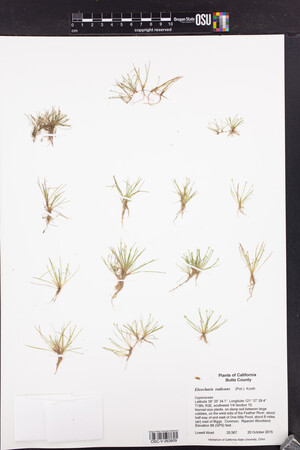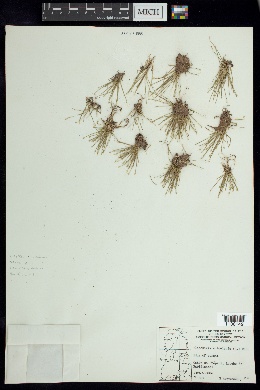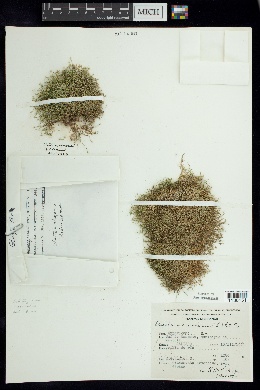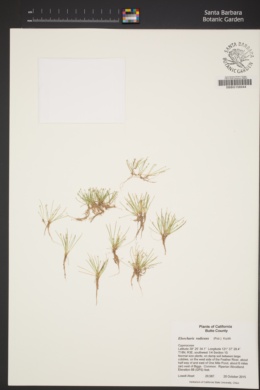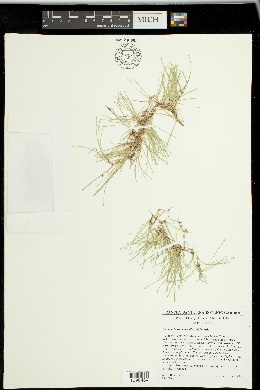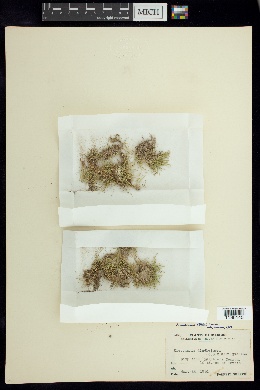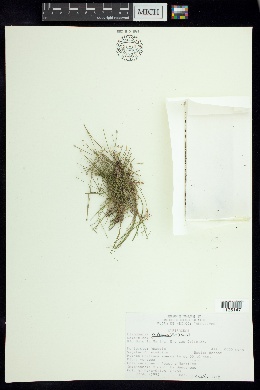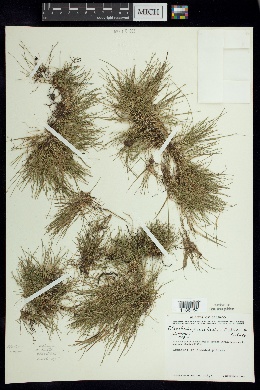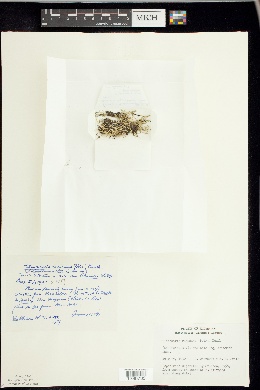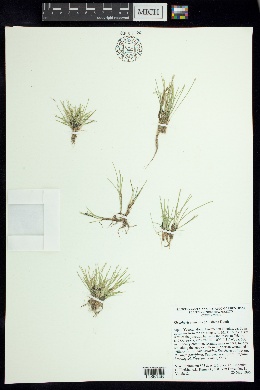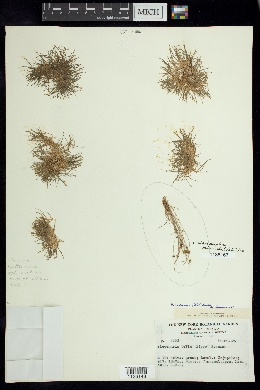Eleocharis radicans
|
|
|
|
Family: Cyperaceae
Rooted Spike-Rush, more...rooted spikerush
[Eleocharis acicularis var. radicans (A. Dietr.) Britt., moreEleocharis lindheimeri Svens.] |
Plants perennial, mat-forming; rhizomes 0.2-0.5 mm thick, longer internodes 5-10 mm, scales not evident. Culms obscurely to ca. 10-ribbed when dry, terete, 1-12 cm × 0.4-1 mm, very soft, spongy. Leaves: distal leaf sheaths fugaceous, colorless, translucent, apex blunt. Spikelets ovoid, 2-3 × 1-1.5 mm, apex acute; scales 5-15, 5-7 per mm of rachilla, colorless to stramineous, rarely slightly reddish, medially broadly greenish to colorless, faintly 3-5-veined, often ovate, membranous, fleshy; proximal scale 2-2.5 × 0.7 mm, other scales 1.5-2 × 0.7 mm, midrib obscure to slightly keeled, apex acute to rounded. Flowers: perianth bristles equaling achene; anthers yellow to brown, 0.3-0.5 mm. Achenes brownish, angles plus longitudinal ridges ca. 7, narrowly obovoid, 2 times longer than wide, 0.75-0.9 × 0.35-0.4 mm, trabeculae ca. 50, distinct. Tubercles brown, pyramidal, 0.15 × 0.15-0.2 mm. Fruiting spring-winter (Apr-Dec). Stream alluvium, lake margins, meadows, seeps, bogs; 100-1400 Ariz., Calif., Fla., La., Mich., Okla., Tex., Va.; n Mexico; West Indies; Central America (El Salvador); South America (Argentina, Chile); Pacific Islands (Hawaii). FNA 2003 Common Name: rooted spikerush Duration: Perennial Nativity: Native Lifeform: Graminoid General: Mat-forming perennial with very minor rhizomes, the scales not even evident, the stems obscurely 10-ribbed, terete, 1-12 cm tall by less than 1 mm wide, soft and spongy. Vegetative: The stem has ephemeral leaf sheaths at the base that are translucent, colorless, and with a blunt apex. Inflorescence: Spikelets ovoid 2-3 mm long by 1-1.5 mm wide, the apex acute, with 5-15 scales, stramineous to slightly reddish, broadly greenish to colorless medially, faintly 3-5 veined, often ovate, membranous, fleshy, the lower scales much larger than others, slightly keeled, the flowers perianth bristles equaling the achene, with yellow to brown anthers less than 1 mm, the achenes brownish with many angles and longitudinal ridges, around 7, narrowly obovoid, 2 times longer than wide. Ecology: Found along water margins and in moist soils, bogs, or wet meadows and in seeps and springs from 1,000-4,500 ft (152-1372 m), flowers from April-December. Notes: Similar to E. bella but differs in having much longer floral scales that are rounded at the apex and not recurved, along with clearly evident rhizomes. Ethnobotany: Unknown Etymology: Eleocharis is from Greek heleos or helos, a marsh, low ground, meadow and charis, grace, beauty, hence marsh grace, while radicans means with rooting stems. Synonyms: Numerous, see Tropicos Editor: SBuckley, 2011 Stems 2-8 dm, 0.25-0.5 mm thick, spongy, becoming rugose- striate when dry; spikelet ovate, usually flattened, 2-4 mm; anthers not over 0.6 mm; bristles not overtopping the tubercle; otherwise much like no. 10 [Eleocharis acicularis (L.) Roem. & Schult.]. Wet sand; trop. Amer., n. to se. Va. and Okla.; Mich. Gleason, Henry A. & Cronquist, Arthur J. 1991. Manual of vascular plants of northeastern United States and adjacent Canada. lxxv + 910 pp. ©The New York Botanical Garden. All rights reserved. Used by permission. |





